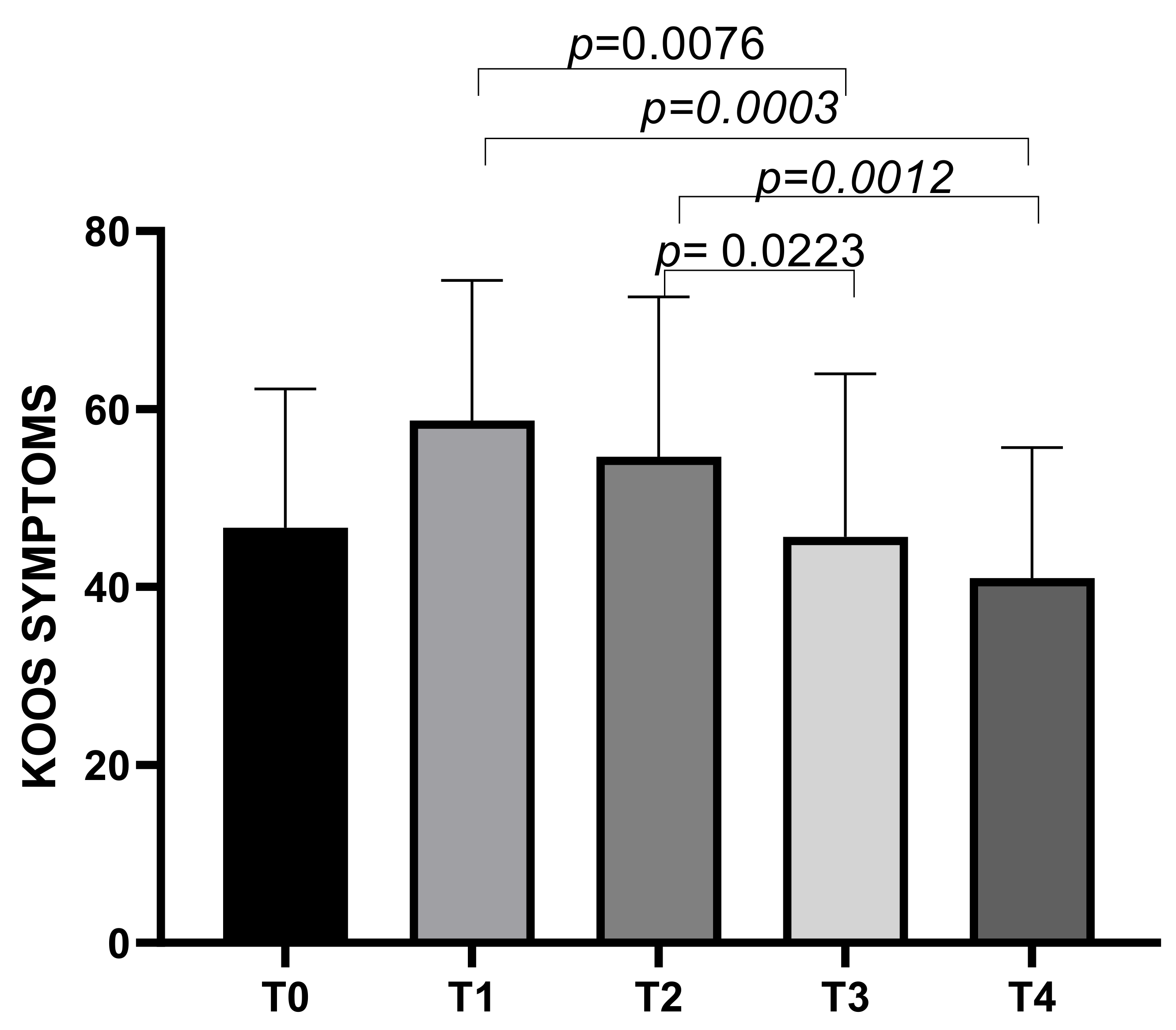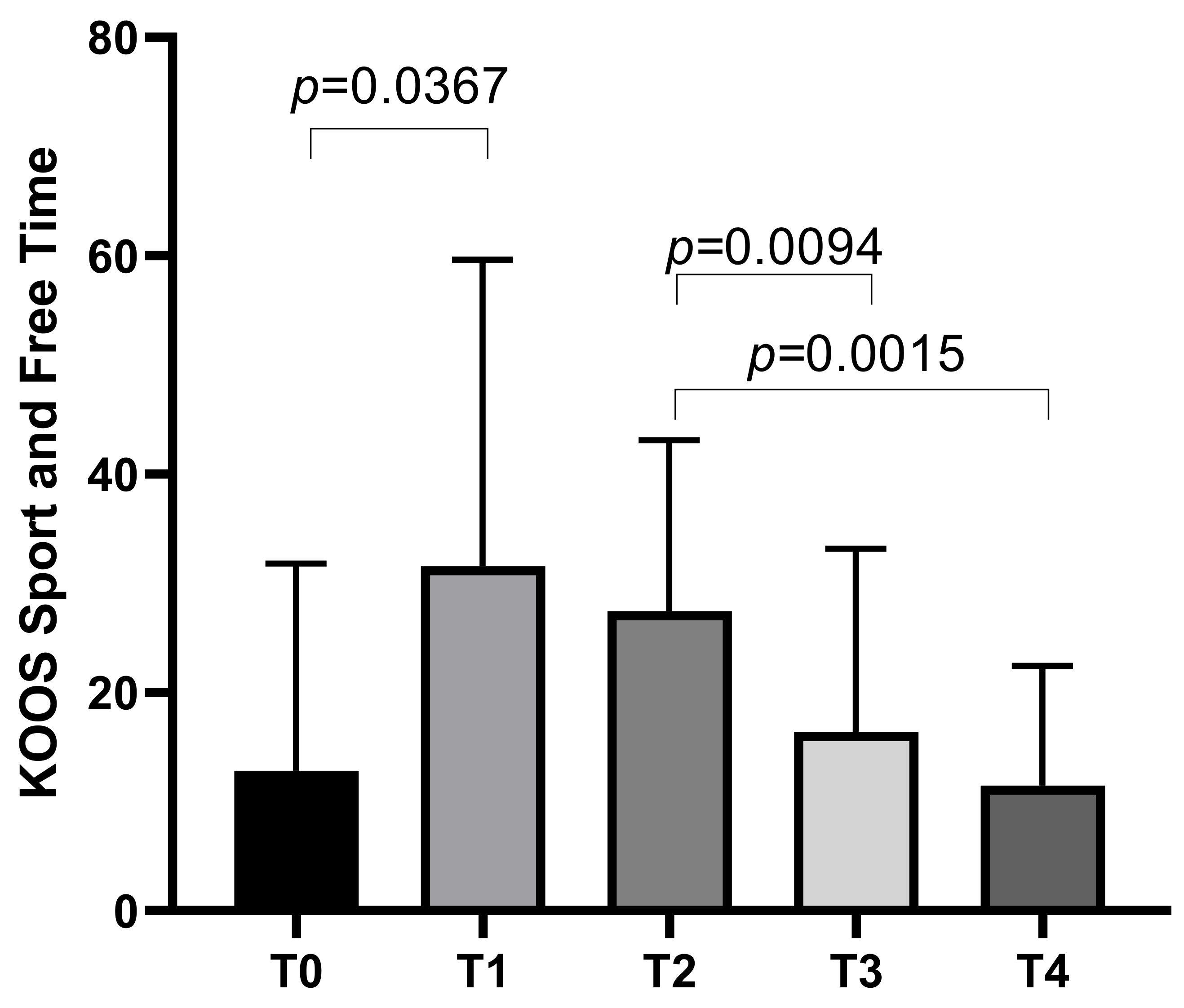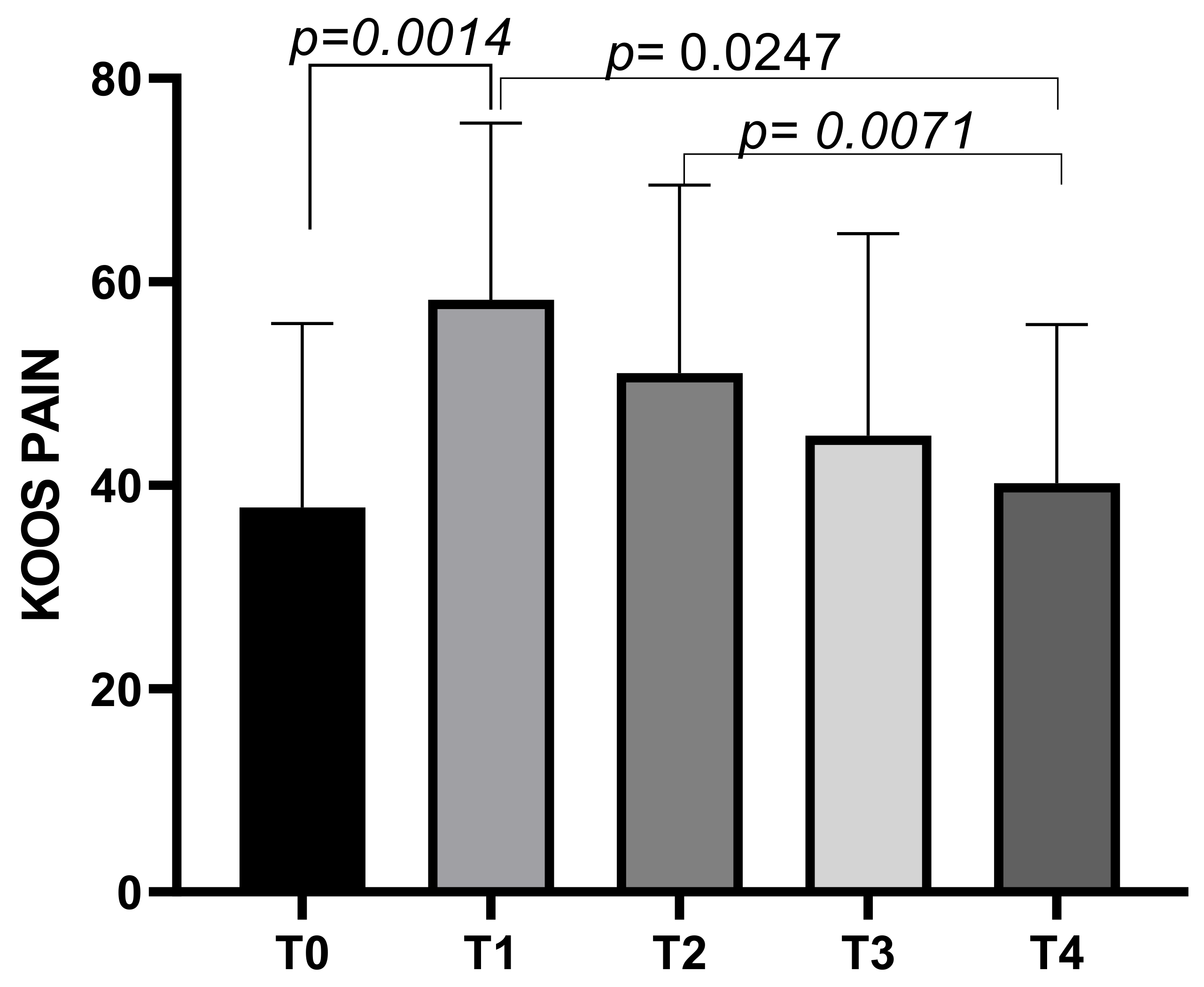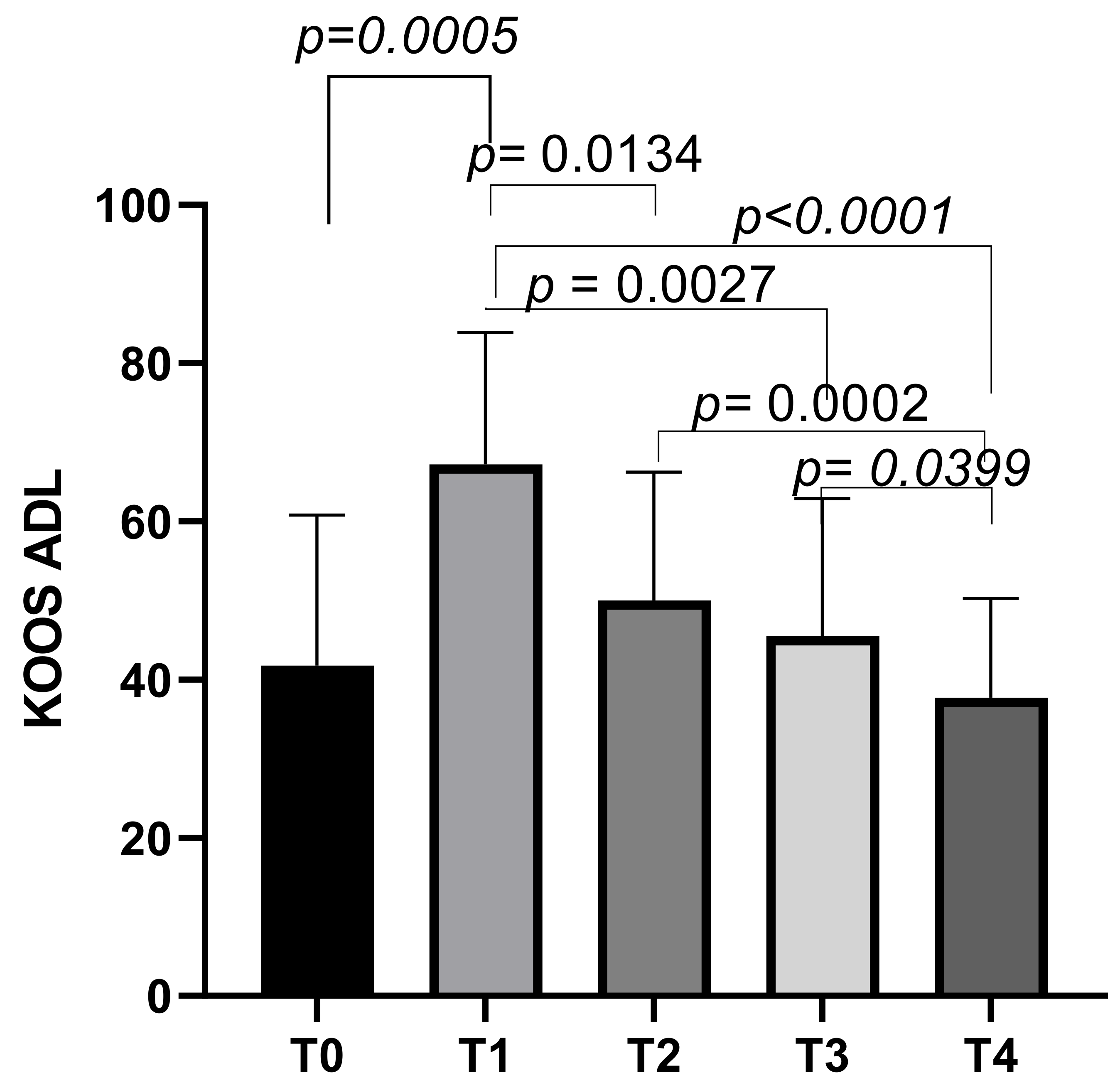Long-Term Efficacy of Carboxymethyl-Chitosan in Advanced Knee Osteoarthritis: A Twelve-Month Follow-Up Study on Non-Responders to Hyaluronic Acid
Abstract
1. Introduction
2. Materials and Methods
2.1. Inclusion and Exclusion Criteria
- Male and female patients of all ages with advanced and symptomatic gonarthrosis (radiographic KL: grade ≥ 3);
- Patients previously unsuccessfully treated with intra-articular HA injections in the knee and subsequently treated at the same level with CM-C;
- Patients with a minimum 12-months follow-up who underwent scheduled clinical assessments at 1, 3, 6, and 12 months.
- Patients not treated with CM-C;
- Patients for whom rating scales were not completed.
2.2. Rating Scales
2.3. Statistical Analysis
3. Results
Correlation Analysis
4. Discussion
Strengths and Limitations
5. Conclusions
Author Contributions
Funding
Institutional Review Board Statement
Informed Consent Statement
Data Availability Statement
Conflicts of Interest
References
- Allen, K.D.; Thoma, L.M.; Golightly, Y.M. Epidemiology of Osteoarthritis. Osteoarthr. Cartil. 2022, 30, 184–195. [Google Scholar] [CrossRef]
- Krakowski, P.; Rejniak, A.; Sobczyk, J.; Karpiński, R. Cartilage Integrity: A Review of Mechanical and Frictional Properties and Repair Approaches in Osteoarthritis. Healthcare 2024, 12, 1648. [Google Scholar] [CrossRef]
- Sharma, L. Osteoarthritis of the Knee. N. Engl. J. Med. 2021, 384, 51–59. [Google Scholar] [CrossRef] [PubMed]
- Wojcieszek, A.; Kurowska, A.; Majda, A.; Liszka, H.; Gądek, A. The Impact of Chronic Pain, Stiffness and Difficulties in Performing Daily Activities on the Quality of Life of Older Patients with Knee Osteoarthritis. Int. J. Environ. Res. Public Health 2022, 19, 16815. [Google Scholar] [CrossRef] [PubMed]
- Hunter, D.J.; Bierma-Zeinstra, S. Osteoarthritis. Lancet 2019, 393, 1745–1759. [Google Scholar] [CrossRef] [PubMed]
- Giorgino, R.; Albano, D.; Fusco, S.; Peretti, G.M.; Mangiavini, L.; Messina, C. Knee Osteoarthritis: Epidemiology, Pathogenesis, and Mesenchymal Stem Cells: What Else Is New? An Update. Int. J. Mol. Sci. 2023, 24, 6405. [Google Scholar] [CrossRef] [PubMed]
- Quintana, J.M. Prevalence of Knee and Hip Osteoarthritis and the Appropriateness of Joint Replacement in an Older Population. Arch. Intern. Med. 2008, 168, 1576. [Google Scholar] [CrossRef] [PubMed]
- Li, D.; Li, S.; Chen, Q.; Xie, X. The Prevalence of Symptomatic Knee Osteoarthritis in Relation to Age, Sex, Area, Region, and Body Mass Index in China: A Systematic Review and Meta-Analysis. Front. Med. 2020, 7, 304. [Google Scholar] [CrossRef] [PubMed]
- Postler, A.; Ramos, A.L.; Goronzy, J.; Günther, K.-P.; Lange, T.; Schmitt, J.; Zink, A.; Hoffmann, F. Prevalence and Treatment of Hip and Knee Osteoarthritis in People Aged 60 Years or Older in Germany: An Analysis Based on Health Insurance Claims Data. Clin. Interv. Aging 2018, 13, 2339–2349. [Google Scholar] [CrossRef]
- Pirri, C.; Sorbino, A.; Manocchio, N.; Pirri, N.; Devito, A.; Foti, C.; Migliore, A. Chondrotoxicity of Intra-Articular Injection Treatment: A Scoping Review. Int. J. Mol. Sci. 2024, 25, 7010. [Google Scholar] [CrossRef] [PubMed]
- Arden, N.K.; Perry, T.A.; Bannuru, R.R.; Bruyère, O.; Cooper, C.; Haugen, I.K.; Hochberg, M.C.; McAlindon, T.E.; Mobasheri, A.; Reginster, J.-Y. Non-Surgical Management of Knee Osteoarthritis: Comparison of ESCEO and OARSI 2019 Guidelines. Nat. Rev. Rheumatol. 2021, 17, 59–66. [Google Scholar] [CrossRef] [PubMed]
- Bannuru, R.R.; Osani, M.C.; Vaysbrot, E.E.; Arden, N.K.; Bennell, K.; Bierma-Zeinstra, S.M.A.; Kraus, V.B.; Lohmander, L.S.; Abbott, J.H.; Bhandari, M.; et al. OARSI Guidelines for the Non-Surgical Management of Knee, Hip, and Polyarticular Osteoarthritis. Osteoarthr. Cartil. 2019, 27, 1578–1589. [Google Scholar] [CrossRef]
- Tschopp, M.; Pfirrmann, C.W.A.; Fucentese, S.F.; Brunner, F.; Catanzaro, S.; Kühne, N.; Zwyssig, I.; Sutter, R.; Götschi, T.; Tanadini, M.; et al. A Randomized Trial of Intra-Articular Injection Therapy for Knee Osteoarthritis. Investig. Radiol. 2023, 58, 355–362. [Google Scholar] [CrossRef] [PubMed]
- Kohn, M.D.; Sassoon, A.A.; Fernando, N.D. Classifications in Brief: Kellgren-Lawrence Classification of Osteoarthritis. Clin. Orthop. Relat. Res. 2016, 474, 1886–1893. [Google Scholar] [CrossRef]
- Vaishya, R.; Pariyo, G.B.; Agarwal, A.K.; Vijay, V. Non-Operative Management of Osteoarthritis of the Knee Joint. J. Clin. Orthop. Trauma 2016, 7, 170–176. [Google Scholar] [CrossRef]
- Gress, K.; Charipova, K.; An, D.; Hasoon, J.; Kaye, A.D.; Paladini, A.; Varrassi, G.; Viswanath, O.; Abd-Elsayed, A.; Urits, I. Treatment Recommendations for Chronic Knee Osteoarthritis. Best Pract. Res. Clin. Anaesthesiol. 2020, 34, 369–382. [Google Scholar] [CrossRef]
- Li, W.; Ayers, D.C.; Lewis, C.G.; Bowen, T.R.; Allison, J.J.; Franklin, P.D. Functional Gain and Pain Relief After Total Joint Replacement According to Obesity Status. J. Bone Jt. Surg. 2017, 99, 1183–1189. [Google Scholar] [CrossRef] [PubMed]
- Postler, A.E.; Lützner, C.; Goronzy, J.; Lange, T.; Deckert, S.; Günther, K.P.; Lützner, J. When Are Patients with Osteoarthritis Referred for Surgery? Best Pract. Res. Clin. Rheumatol. 2023, 37, 101835. [Google Scholar] [CrossRef] [PubMed]
- Manning, L.; Davis, J.S.; Robinson, O.; Clark, B.; Lorimer, M.; De Steiger, R.; Graves, S.E. High Prevalence of Older Australians with One or More Joint Replacements: Estimating the Population at Risk for Late Complications of Arthroplasty. ANZ J. Surg. 2020, 90, 846–850. [Google Scholar] [CrossRef] [PubMed]
- Yi, P.H.; Della Valle, C.J.; Fishman, E.K.; Fritz, J. Imaging of Periprosthetic Fractures of the Hip and Knee. Semin. Roentgenol. 2021, 56, 90–105. [Google Scholar] [CrossRef] [PubMed]
- Nozaka, K.; Miyakoshi, N.; Hongo, M.; Kasukawa, Y.; Saito, H.; Kijima, H.; Tsuchie, H.; Mita, M.; Shimada, Y. Effectiveness of Circular External Fixator in Periprosthetic Fractures around the Knee. BMC Musculoskelet. Disord. 2020, 21, 317. [Google Scholar] [CrossRef] [PubMed]
- Zhao, D.; Yu, S.; Sun, B.; Gao, S.; Guo, S.; Zhao, K. Biomedical Applications of Chitosan and Its Derivative Nanoparticles. Polymers 2018, 10, 462. [Google Scholar] [CrossRef] [PubMed]
- Oprenyeszk, F.; Sanchez, C.; Dubuc, J.-E.; Maquet, V.; Henrist, C.; Compère, P.; Henrotin, Y. Chitosan Enriched Three-Dimensional Matrix Reduces Inflammatory and Catabolic Mediators Production by Human Chondrocytes. PLoS ONE 2015, 10, e0128362. [Google Scholar] [CrossRef]
- Chien, R.-C.; Yen, M.-T.; Mau, J.-L. Antimicrobial and Antitumor Activities of Chitosan from Shiitake Stipes, Compared to Commercial Chitosan from Crab Shells. Carbohydr. Polym. 2016, 138, 259–264. [Google Scholar] [CrossRef]
- Vandeweerd, J.-M.; Innocenti, B.; Rocasalbas, G.; Gautier, S.E.; Douette, P.; Hermitte, L.; Hontoir, F.; Chausson, M. Non-Clinical Assessment of Lubrication and Free Radical Scavenging of an Innovative Non-Animal Carboxymethyl Chitosan Biomaterial for Viscosupplementation: An in-Vitro and Ex-Vivo Study. PLoS ONE 2021, 16, e0256770. [Google Scholar] [CrossRef] [PubMed]
- Desai, N.; Rana, D.; Salave, S.; Gupta, R.; Patel, P.; Karunakaran, B.; Sharma, A.; Giri, J.; Benival, D.; Kommineni, N. Chitosan: A Potential Biopolymer in Drug Delivery and Biomedical Applications. Pharmaceutics 2023, 15, 1313. [Google Scholar] [CrossRef] [PubMed]
- Manocchio, N.; Ljoka, C.; Piacentini, N.; Sorge, R.; Vita, G.; Foti, C. Intra-Articular Injections with Carboxymethyl-Chitosan in Patients Affected by Knee Osteoarthritis Non-Responders to Hyaluronic Acid: A Pilot Study. Eur. J. Transl. Myol. 2024, 34, 12413. [Google Scholar] [CrossRef] [PubMed]
- World Medical Association. World Medical Association Declaration of Helsinki: Ethical Principles for Medical Research Involving Human Subjects. JAMA 2013, 310, 2191. [Google Scholar] [CrossRef]
- Mavrov, M. The Law Institute of Patient’s Informed Consent; Publishing House Stovi Group Bulgaria: Maritsa, Bulgaria, 2018; pp. 17–18. [Google Scholar]
- Scott, J.; Huskisson, E.C. Graphic Representation of Pain. Pain 1976, 2, 175–184. [Google Scholar] [CrossRef] [PubMed]
- Monticone, M.; Ferrante, S.; Salvaderi, S.; Rocca, B.; Totti, V.; Foti, C.; Roi, G.S. Development of the Italian Version of the Knee Injury and Osteoarthritis Outcome Score for Patients with Knee Injuries: Cross-Cultural Adaptation, Dimensionality, Reliability, and Validity. Osteoarthr. Cartil. 2012, 20, 330–335. [Google Scholar] [CrossRef]
- Roos, E.M.; Lohmander, L.S. The Knee Injury and Osteoarthritis Outcome Score (KOOS): From Joint Injury to Osteoarthritis. Health Qual. Life Outcomes 2003, 1, 64. [Google Scholar] [CrossRef] [PubMed]
- Ithurburn, M.P.; Paterno, M.V.; Thomas, S.; Pennell, M.L.; Evans, K.D.; Magnussen, R.A.; Schmitt, L.C. Clinical Measures Associated with Knee Function over Two Years in Young Athletes after ACL Reconstruction. Knee 2019, 26, 355–363. [Google Scholar] [CrossRef]
- Abujaber, S.; Altubasi, I.; Hamdan, M.; Al-Zaben, R. Impact of End-Stage Knee Osteoarthritis on Perceived Physical Function and Quality of Life: A Descriptive Study from Jordan. PLoS ONE 2023, 18, e0286962. [Google Scholar] [CrossRef] [PubMed]
- Rienstra, W.; Stevens, M.; Blikman, T.; Bulstra, S.K.; Van Den Akker-Scheek, I. Responsiveness and Interpretability of the Pain Subscale of the Knee and Hip Osteoarthritis Outcome Scale (KOOS and HOOS) in Osteoarthritis Patients According to COSMIN Guidelines. PLoS ONE 2023, 18, e0293760. [Google Scholar] [CrossRef] [PubMed]
- Parkes, M.J.; Callaghan, M.J.; O’Neill, T.W.; Forsythe, L.M.; Lunt, M.; Felson, D.T. Sensitivity to Change of Patient-Preference Measures for Pain in Patients With Knee Osteoarthritis: Data From Two Trials. Arthritis Care Res. 2016, 68, 1224–1231. [Google Scholar] [CrossRef]
- Sadosky, A.; Parsons, B.; Emir, B.; Nieshoff, E.C. Pain Relief and Functional Improvement in Patients with Neuropathic Pain Associated with Spinal Cord Injury: An Exploratory Analysis of Pregabalin Clinical Trials. J. Pain Res. 2016, 9, 405–416. [Google Scholar] [CrossRef][Green Version]
- Peck, J.; Slovek, A.; Miro, P.; Vij, N.; Traube, B.; Lee, C.; Berger, A.A.; Kassem, H.; Kaye, A.D.; Sherman, W.F.; et al. A Comprehensive Review of Viscosupplementation in Osteoarthritis of the Knee. Orthop. Rev. 2021, 13, 25549. [Google Scholar] [CrossRef] [PubMed]
- Park, J.-G.; Sim, J.; Han, S.-B. Association between Intra-Articular Hyaluronic Acid Injections in Delaying Total Knee Arthroplasty and Safety Evaluation in Primary Knee Osteoarthritis: Analysis Based on Health Insurance Review and Assessment Service (HIRA) Claim Database in Republic of Korea. BMC Musculoskelet. Disord. 2024, 25, 706. [Google Scholar] [CrossRef]
- Baroncini, A.; Maffulli, N.; Schäfer, L.; Manocchio, N.; Bossa, M.; Foti, C.; Klimuch, A.; Migliorini, F. Physiotherapeutic and Non-Conventional Approaches in Patients with Chronic Low-Back Pain: A Level I Bayesian Network Meta-Analysis. Sci. Rep. 2024, 14, 11546. [Google Scholar] [CrossRef] [PubMed]
- Rhon, D.I.; Kim, M.; Asche, C.V.; Allison, S.C.; Allen, C.S.; Deyle, G.D. Cost-Effectiveness of Physical Therapy vs Intra-Articular Glucocorticoid Injection for Knee Osteoarthritis: A Secondary Analysis From a Randomized Clinical Trial. JAMA Netw. Open 2022, 5, e2142709. [Google Scholar] [CrossRef]
- Dantas, L.O.; Salvini, T.D.F.; McAlindon, T.E. Knee Osteoarthritis: Key Treatments and Implications for Physical Therapy. Braz. J. Phys. Ther. 2021, 25, 135–146. [Google Scholar] [CrossRef] [PubMed]
- Ressler, A. Chitosan-Based Biomaterials for Bone Tissue Engineering Applications: A Short Review. Polymers 2022, 14, 3430. [Google Scholar] [CrossRef]
- Mou, D.; Yu, Q.; Zhang, J.; Zhou, J.; Li, X.; Zhuang, W.; Yang, X. Intra-Articular Injection of Chitosan-Based Supramolecular Hydrogel for Osteoarthritis Treatment. Tissue Eng. Regen. Med. 2021, 18, 113–125. [Google Scholar] [CrossRef] [PubMed]
- Liu, F.; Li, H.-Y.; Wang, Z.; Zhang, H.-N.; Wang, Y.-Z.; Xu, H. Carboxymethyl Chitosan Reduces Inflammation and Promotes Osteogenesis in a Rabbit Knee Replacement Model. BMC Musculoskelet. Disord. 2020, 21, 775. [Google Scholar] [CrossRef] [PubMed]
- Machrowska, A.; Karpiński, R.; Maciejewski, M.; Jonak, J.; Krakowski, P.; Syta, A. Application of Recurrence Quantification Analysis in the Detection of Osteoarthritis of the Knee with the Use of Vibroarthrography. Adv. Sci. Technol. Res. J. 2024, 18, 19–31. [Google Scholar] [CrossRef] [PubMed]
- Machrowska, A.; Karpiński, R.; Maciejewski, M.; Jonak, J.; Krakowski, P. Application of Eemd-Dfa Algorithms and Ann Classification for Detection of Knee Osteoarthritis Using Vibroarthrography. Appl. Comput. Sci. 2024, 20, 90–108. [Google Scholar] [CrossRef]
- Emans, P.J.; Skaliczki, G.; Haverkamp, D.; Bentin, J.; Chausson, M.; Schifflers, M.; Hermitte, L.; Douette, P. First-in-Human Study to Evaluate a Single Injection of KiOmedine®CM-Chitosan for Treating Symptomatic Knee Osteoarthritis. TORJ Open Rheumatol. J. 2022, 16, e187431292206100. [Google Scholar] [CrossRef]
- Emans, P.J.; Skaliczki, G.; Haverkamp, D.; Bentin, J.; Chausson, M.; Schifflers, M.; Portelange, N. KiOmedine® CM-Chitosan Is Effective for Treating Advanced Symptomatic Knee Osteoarthritis up to Six Months Following a Single Intra-Articular Injection: A Post Hoc Analysis of Aproove Clinical Study. TORJ Open Rheumatol. J. 2023, 17, e187431292302010. [Google Scholar] [CrossRef]
- Lynen, N.A.; Eichhorn, C.; Portelange, N.; Chausson, M.; Weyenberg, W. Long-Term Efficacy Following Intra-Articular Injection of Carboxymethyl-Chitosan, a New Product Class for Knee Osteoarthritis: Results from an Observational Study in Germany. Rheumatol. Ther. 2024, 11, 649–662. [Google Scholar] [CrossRef] [PubMed]






| Time Point | VAS vs. KOOS Pain (r) | VAS vs. KOOS Symptoms (r) | VAS vs. KOOS ADL (r) | VAS vs. KOOS Sport and Free Time (r) | VAS vs. KOOS QOL (r) |
|---|---|---|---|---|---|
| T0 | −0.6165 * | −0.8159 *** | −0.354 | −0.2919 | −0.4465 |
| T1 | −0.6448 ** | −0.6249 ** | −0.383 | −0.47 | −0.4057 |
| T2 | −0.6641 ** | −0.6428 ** | −0.5929 * | −0.6274 ** | −0.8129 *** |
| T3 | −0.8034 *** | −0.8089 *** | −0.6862 ** | −0.8521 *** | −0.7383 ** |
| T4 | −0.602 * | −0.8143 *** | −0.5703 * | −0.5765 * | −0.5711 * |
Disclaimer/Publisher’s Note: The statements, opinions and data contained in all publications are solely those of the individual author(s) and contributor(s) and not of MDPI and/or the editor(s). MDPI and/or the editor(s) disclaim responsibility for any injury to people or property resulting from any ideas, methods, instructions or products referred to in the content. |
© 2025 by the authors. Licensee MDPI, Basel, Switzerland. This article is an open access article distributed under the terms and conditions of the Creative Commons Attribution (CC BY) license (https://creativecommons.org/licenses/by/4.0/).
Share and Cite
Manocchio, N.; Pirri, C.; Ljoka, C.; Sorbino, A.; Piacentini, N.; Monello, C.; Vita, G.; Foti, C. Long-Term Efficacy of Carboxymethyl-Chitosan in Advanced Knee Osteoarthritis: A Twelve-Month Follow-Up Study on Non-Responders to Hyaluronic Acid. Biomedicines 2025, 13, 270. https://doi.org/10.3390/biomedicines13020270
Manocchio N, Pirri C, Ljoka C, Sorbino A, Piacentini N, Monello C, Vita G, Foti C. Long-Term Efficacy of Carboxymethyl-Chitosan in Advanced Knee Osteoarthritis: A Twelve-Month Follow-Up Study on Non-Responders to Hyaluronic Acid. Biomedicines. 2025; 13(2):270. https://doi.org/10.3390/biomedicines13020270
Chicago/Turabian StyleManocchio, Nicola, Carmelo Pirri, Concetta Ljoka, Andrea Sorbino, Nicolò Piacentini, Cristiano Monello, Giulia Vita, and Calogero Foti. 2025. "Long-Term Efficacy of Carboxymethyl-Chitosan in Advanced Knee Osteoarthritis: A Twelve-Month Follow-Up Study on Non-Responders to Hyaluronic Acid" Biomedicines 13, no. 2: 270. https://doi.org/10.3390/biomedicines13020270
APA StyleManocchio, N., Pirri, C., Ljoka, C., Sorbino, A., Piacentini, N., Monello, C., Vita, G., & Foti, C. (2025). Long-Term Efficacy of Carboxymethyl-Chitosan in Advanced Knee Osteoarthritis: A Twelve-Month Follow-Up Study on Non-Responders to Hyaluronic Acid. Biomedicines, 13(2), 270. https://doi.org/10.3390/biomedicines13020270







